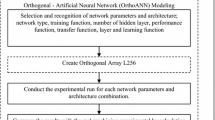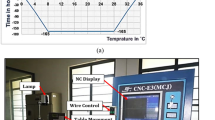Abstract
This study mainly investigates the effect and optimization of process parameters on surface integrity including white layer thickness and crack density in wire electrical discharge machining (WEDM) of tungsten tool YG15 which is one of the most important hardened stainless steel alloys used in the mold industries. In this paper, four input process parameters including pulse-on time, pulse current, water pressure, and feed rate were set during WEDM experiment, and three output characteristics including surface roughness (SR), white layer thickness (WLT), and surface crack density (SCD) were taken as the performance criteria of surface integrity. Then an experiment for central composite design (CCD) of processing the tungsten tool YG15 has been conducted according to response surface methodology (RSM). After analyzing the experimental results and optimizing the WEDM process using two different methods namely backpropagation neural network combined with genetic algorithm (BPNN-GA) and Non-dominated Sorting Genetic Algorithm-II (NSGA-II), the optimal solution can be obtained. The analysis results manifest that the pulse-on time and pulse current have a significant effect on the SR, WLT, and SCD. Moreover, several confirmation tests were carried out to verify the efficiency of the optimization methods, and then the more appropriate method was demonstrated by the comparison of optimization results. According to analysis and discussion of results, the most suitable process parameter combinations can be obtained to guide the actual machine, which contribute to increase the surface integrity and accuracy of WEDM and simultaneously reduce the ratio of disqualification for industrial application.
Similar content being viewed by others
References
Newton TR, Melkote SN, Watkins TR, Trejo RM, Reister L (2009) Investigation of the effect of process parameters on the formation and characteristics of recast layer in wire-edm of inconel 718. Mater Sci Eng A-Struct 513:208–215
Qu J, Scattergood RO, Shih AJ (2002) Development of the cylindrical wire electrical discharge machining process, part 2: surface integrity and roundness. J Manuf Sci Eng 124(3):708–714
Velterop L (2003) Influence of wire electrical discharge machining on the fatigue properties of high strength stainless steel. Mater Sci Forum 426-432:1017–1022
Caydas U, Ahmet H (2007) Modeling and analysis of electrode wear and white layer thickness in die-sinking edm process through response surface methodology. Int J Adv Manuf Technol 38(11-12):1148–1156
Yildiz Y, Sundaram MM, Rajurkar KP (2013) Empirical modeling of the white layer thickness formed in electrodischarge drilling of berylliumCcopper alloys. Int J Adv Manuf Technol 66(9-12):1745–1755
Pradhan MK (2013) Estimating the effect of process parameters on surface integrity of edmed aisi d2 tool steel by response surface methodology coupled with grey relational analysis. Int J Adv Manuf Technol 67(9-12):2051–2062
Lee HT, Tai TY (2003) Relationship between edm parameters and surface crack formation. J Mater Process Technol 142(3):676–683
Puri AB, Bhattacharyya B (2005) Modeling and analysis of white layer depth in a wire-cut edm process through response surface methodology. Int J Adv Manuf Technol 25(3-4):301–307
Shahali H, Yazdi MRS, Mohammadi A, Iimanian E (2012) Optimization of surface roughness and thickness of white layer in wire electrical discharge machining of din 1.4542 stainless steel using micro-genetic algorithm and signal to noise ratio techniques. Proc IME B J Eng Manuf 226(5):803–812
Shabgard M, Oliaei SNB, Seyedzavvar M, Najadebrahimi A (2011) Experimental investigation and 3d finite element prediction of the white layer thickness, heat affected zone, and surface roughness in edm process. J Mech Sci Technol 25(12):3173–3183
Zhang G, Zhang Z, Ming W, Guo J, Huang Y, Shao X (2014) The multi-objective optimization of medium-speed wedm process parameters for machining skd11 steel by the hybrid method of rsm and nsga-ii. Int J Adv Manuf Technol 70(9-12):2097–2109
Ming W, Zhang Z, Zhang G, Huang Y, Guo J, Chen Y (2014) Multi-objective optimization of 3d-surface topography of machining yg15 in wedm. Mater Manuf Processes 29(5):514–525
Zhang G, Zhang Z, Guo J, Ming W, Li M, Huang Y (2013) Modeling and optimization of medium-speed wedm process parameters for machining skd11. Mater Manuf Processes 28(10):1124–1132
Rong Y, Zhang Z, Zhang G, Yue C, Gu Y, Huang Y, Wang C, Shao X (2015) Parameters optimization of laser brazing in crimping butt using taguchi and bpnn-ga. Opt Lasers Eng 67:94–104
Montgomery DC (2001) Design and analysis of experiments. Wiley, Hoboken
Zhang G, Chen Z, Zhang Z, Huang Y, Ming W, Li H (2014) A macroscopic mechanical model of wire electrode deflection considering temperature increment in ms-wedm process. Int J Mach Tools Manuf 78:41–53
Bhattacharyya B, Gangopadhyay S, Sarkar BR (2007) Modelling and analysis of edmed job surface integrity. J Mater Process Technol 189(1):169–177
Deb K, Pratap A, Agarwal S, Meyarivan T (2002) A fast and elitist multiobjective genetic algorithm: NSGA-II. IEEE T Evolut Comput 6:182–197
Author information
Authors and Affiliations
Corresponding author
Rights and permissions
About this article
Cite this article
Zhang, Z., Ming, W., Huang, H. et al. Optimization of process parameters on surface integrity in wire electrical discharge machining of tungsten tool YG15. Int J Adv Manuf Technol 81, 1303–1317 (2015). https://doi.org/10.1007/s00170-015-7266-0
Received:
Accepted:
Published:
Issue Date:
DOI: https://doi.org/10.1007/s00170-015-7266-0




